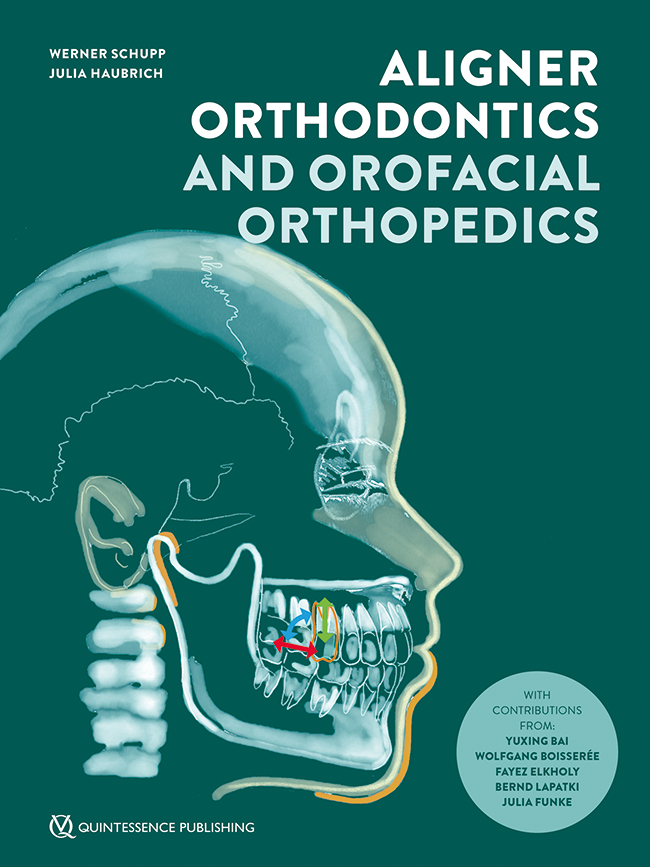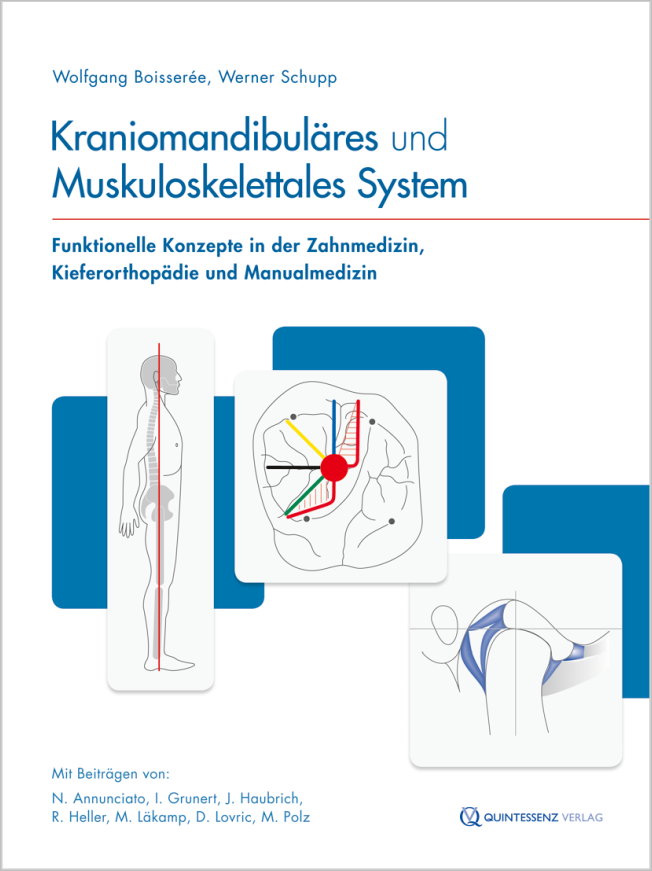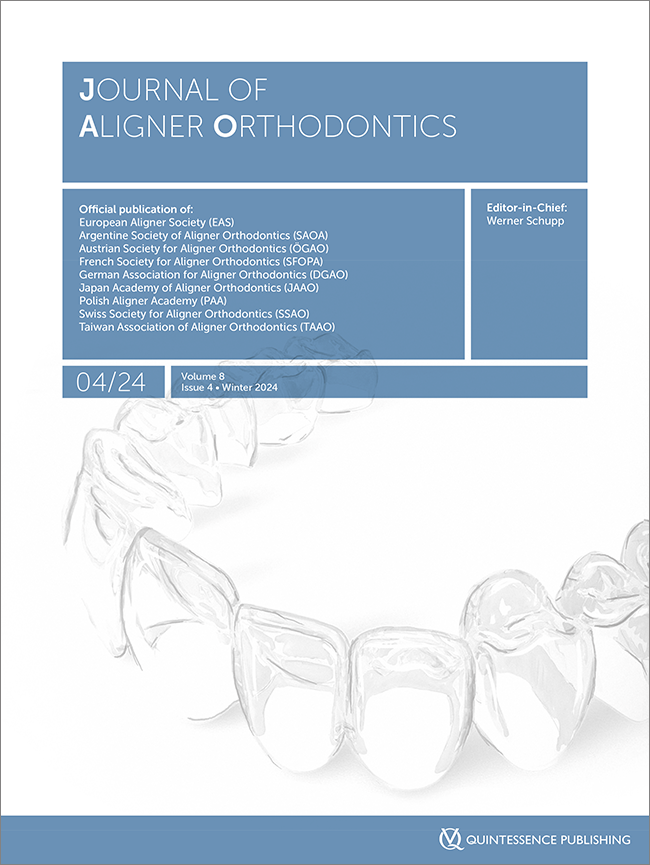Journal of Aligner Orthodontics, 3/2024
Case reportPages 207-227, Language: EnglishHaubrich, Julia / Schupp, Werner / Boisserée, WolfgangAligner therapy offers a valuable alternative to fixed appliance treatment in young and adult patients, making it possible to reduce potential side effects and providing an aesthetic therapeutic option. In some patients, abrasions, changes of tooth shape or loss of tooth substance require an additional tooth restoration to obtain an optimal outcome that satisfies the patient. Instead of reducing healthy tooth substance for the preparation of a crown or veneer, the development of composite in the past few years has led to improved results in terms of both longevity and aesthetics. The present article outlines different patient examples of interdisciplinary treatment with aligner orthodontics followed by minimally invasive restorations with composites on anterior teeth.
Keywords: aligner orthodontics, attachments, composite, in-office aligners, interdisciplinary dentistry, Invisalign, minimally invasive restorations, OnyxCeph Aligner 3D software
Journal of Aligner Orthodontics, 1/2024
Case reportPages 7-24, Language: EnglishHaubrich, Julia / Schupp, WernerNowadays, aligner orthodontics offers a range of treatment possibilities for almost every type of malocclusion. The latest developments in software and printers provide practitioners with options for altering aligner margins, material stiffness and thickness, and other key aspects in aligner orthodontics like direct printed aligners. Covering the palate and using aligners with longer margins instead of scalloped aligners and torque elements in aligner therapy increases the biomechanical force transferred onto the posterior teeth and enables the practitioner to improve predictability when widening the arches without major loss of crown torque. The present article describes the treatment of two patients with in-office aligners and coverage of the maxillary palate.
Keywords: aligner orthodontics, in-office aligners, OnyxCeph software, palatal coverage, transverse expansion
Dentista, 4/2023
FokusPages 32-37, Language: GermanFunke, Julia / Haubrich, Julia / Schupp, WernerDie Alignertherapie ist heute in aller Munde. 24 Jahre nach der Markteinführung von Invisalign durch Align Technology (San Jose, USA) hat sich auf dem Gebiet der transparenten Zahnkorrekturschienen einiges getan: Die Materialentwicklung ist vorangeschritten und es gibt zahlreiche klinische Studien zur Behandlung mit Alignern, sodass sich auch ehemalige Kritiker zunehmend der Aligner-Technologie öffnen.
Journal of Aligner Orthodontics, 4/2023
Original Scientific ArticlePages 307-315, Language: EnglishGroß, Ann-Sophie / Haubrich, Julia / Schupp, Werner / Bourauel, ChristophObjective: The aim of this study was to investigate the incidence and severity of root resorption in patients treated with Invisalign aligners (Align Technology, San Jose, CA, USA) and to examine a larger number of factors with a higher number of patient treatments, in comparison to the current literature, to show correlations between these factors and root resorption.Materials and methods: The study group comprised 108 patients treated with Invisalign appliances. From these 108 patients, a total of 1,567 teeth were measured twice in panoramic radiographs before (T1) and after (T2) orthodontic treatment. The following teeth (according to FDI notation) were assessed: 16, 14, 13, 12, 11, 21, 22, 23, 24, 26, 36, 33, 32, 31, 41, 42, 43 and 46. The parameters determined from the patient records and examined were as follows: sex, age, arch (mandible or maxilla), side (right or left), tooth position (anterior or posterior), tooth type (central incisor, lateral incisor, canine, first premolar, first molar), position in the arch (anterior mandible, anterior maxilla, posterior maxilla, posterior mandible), Angle Class (I, II, III), reverse articulation, deep bite, open bite, gap position, crowding, use of elastics, use of motion appliances, extrusion, intrusion, translation, rotation, angulation, inclination, number of ClinCheck plans, total number of aligners (treatment time), and number of aligners per ClinCheck. Root resorption was determined by root–crown ratio and calculated according to the Linge-Linge formula.Results: All patients displayed root resorption, but only 20 of the 1,567 teeth showed clinically relevant root resorption of more than 20%. Three-quarters (75.2%) of the total sample had only mild root resorption (under 9.7% resorption). The following parameters were statistically significant and showed a correlation with the occurrence of root resorption: central incisors, intrusion, posterior maxilla and anterior mandible. Increased angulation also tended to be associated with increased root resorption, but this did not reach the 5% threshold. Finally, the treatment duration (total number of aligners) and the average number of aligners per ClinCheck were significantly associated with increased root resorption.Conclusions: Orthodontic treatment with Invisalign aligners can lead to root resorption. All patients showed root resorption, but this was mainly mild, without recorded clinical relevance. In order to reduce root resorption during orthodontic treatment, the orthodontist should pay special attention to the movement of the central incisors, movements through the cortical bone, intrusions and angulations, and slower staging.
Keywords: aligners, Invisalign, orthodontics, root resorption
Journal of Aligner Orthodontics, 4/2023
Method presentationPages 267-283, Language: EnglishSchupp, Werner / Haubrich, Julia / Funke, JuliaThe assignment of the mandible to the maxilla and thus the occlusal relationship in the virtual treatment simulation was previously performed exclusively in centric occlusion by means of a buccal scan. When the tooth position is changed in the virtual treatment simulation, the assignment of the mandible to the new occlusion is made by means of “best fit”, a pure vertical elevation of the mandible that differs from the closing and opening movement of the mandible in real motion according to the global centre of rotation, formerly known as the hinge axis. Thus, the occlusal relationship set at the end of the virtual treatment simulation always differs from the patient’s occlusion at the end of treatment. Recording the real motion and subsequent matching in the virtual treatment simulation, on the other hand, makes it possible to correct virtual tooth positions under the patient’s individual opening and closing movement using their real motion within the global centre of rotation. In addition, the assignment of the mandible to the maxilla in the virtual treatment simulation can take place in a corrected, physiological condylar position. Arch motion analysis, followed by use of the virtual articulator in the virtual treatment simulation, represents the missing link in a fully digital orthodontic workflow.
Keywords: aligner orthodontics, articulator, digital joint recording, Digital Motion Decoder, occlusion, temporomandibular disorder, temporomandibular joint, virtual articulator, virtual treatment simulation
Journal of Aligner Orthodontics, 3/2023
Case reportPages 195-216, Language: EnglishHaubrich, Julia / Schupp, WernerThe approach used to treat open bite depends on the origin of the anomaly and the Angle classification. This vertical deviation can be dental or skeletal in nature, or both combined. If removable appliances, such as an oral vestibular plate, or palatal expansion and myofunctional therapy are used in early treatments, multibracket therapy, extraction therapy or orthodontic treatment in combination with surgery are most used in the permanent dentition. Aligner therapy offers a valuable alternative approach for treating dentoalveolar open bite, and its use in combination with skeletal anchorage broadens the spectrum of orthodontics even more. The present article shows different examples of open bite patients treated with aligner orthodontics alone and discusses the incorporation of virtual articulators in treatment planning.
Keywords: aligner orthodontics, attachments, Dental Motion Decoder-System software, extrusion, in-office aligners, interdisciplinary dentistry, intrusion, Invisalign, OnyxCeph Aligner 3D software, open bite, virtual articulator






